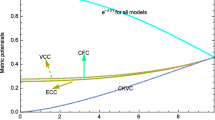Abstract
In this article the GEM (Brandenburg, 1992; Brandenburg, 1988) theory is applied to the problem of the cosmos in which most of the matter is hydrogen, spacetime is flat, and a Cosmic Background Radiation CBR field exists. Using the two postulates of the GEM theory: 1. That gravity fields are equivalent to an array ofE ×B drifts or a spacially varying Poynting field, such that spacetime is determined by EM fields so that the stress tensor of ultrastrong fields is self-canceling; 2. That EM and gravity fields and protons and electrons are unified at the Planck scale of lengths and energies and split apart to form distinct fields and separate particles at the “Mesoscale” of normal particle rest energies and classical radii. A new derivation is made of the formula forG found previously:G =e 2/(m p m e )α exp(-2R 1/2) = 6.668 × 10−8 dynes cm2 g−2wherem p andm e are the proton and electron masses respectively,R =m p /m e andα is the fine structure constant, shows that quantum processes may occur which make the vacuum unstable to appearance of hydrogen thus allowing matter creation and a steady state universe to occur. The value for the Hubble Time calculated from this model isT o = (3/((2α)(αR 1/2)4))1/3(r e /c)(e 2/Gm p m e )= 19 Gyr wherer e =e 2 / (m e c 2)and follows the form first hypothesized by Dirac(1937). The CBR is traced to this process of matter creation and its temperature is calculated as beingT CBR = ((3/4)Gm e 2 c/(σ 2 σ o ))1/4 = 2.66K whereσ is the Thomson cross section of the electron andσ o is the Stefan-Boltzman constant.
Similar content being viewed by others
References
Alfvén, H.: 1990, “Cosmology in the Plasma Universe”,IEEE Trans. Plasma Sci. Vol.18, pp. 5–10
Arp, H.: 1991, “Exploding the Big Bang Hypothesis”,Physics Today Vol.44, pp. 85–86
Brandenburg, J. E.: 1988,“The GEM Unification Theory: Part III”,Bull. Am. Phys. Soc. Vol.32, p. 1049
Brandenburg, J. E.: 1992, “Unification of gravity and electromagnetism in the plasma universe”,IEEE Trans. Plasma Sci. Vol.20, pp. 944–957
Cohen, E. R. and B. N. Taylor: 1989, “The Fundamental Physical Constants”,Physics Today Vol.42, pp. 8
Dirac, P.A.M.: 1937, “The Cosmological Constants”Nature, Vol.139, p. 323. Also in Lee Smolin, “Stochastic Mechanics, Hidden Variables and Gravity,” inQuantum Concepts in Space and Time.
Hawking, S. W.: 1992,A Brief History of Time Bantam Books, New York, pp. 151
Hellings, R. W., P.J. Adams, J.D. Anderson, M. S. Keesey, E. L. Lau, E. M. Standish, V.M. Canuto and I. Goldman: 1982, “Experimental Test of the Variabilty of G Using Viking Lander Ranging Data”,Phys. Rev. Lett. Vol.51, pp. 1609–1612
Hoyle, F.: 1948, “A New Model For the Expanding Universe”,Mon. Not. R. Astronomy Soc. Vol.108, pp. 372–382
Kar'orolyhazy F., A. Frankel, and B. Luka'cs: 1989,“On the Possible Role of Gravity in the Reduction of the Wavefunction”, inQuantum Concepts in Space and Time Edited by R. Pervioc and C. J. Isham, Clarendon Press,Oxford, pp. 112
Linde, A.: 1992,“Particle Physics and Inflationary Cosmology”,Physics Today Vol.40, pp. 61–68
Misner, C. W., Kip S.Thorne, and John Archibald Wheeler: 1971,Gravitation W. H. Freeman and Company, San Fransisco,, pp. 1061
Peratt, A. L.: 1992, “Plasma Cosmology”,Sky and Tel. February, p. 136
Putfoff, H. E.: 1992,“Gravity as a Zero Point Fluctuation Force”,Phys. Rev. A. Vol.39, pp. 2333
Raby, S. A., R. Slansky, and G. B. West: 1988,“Particle Physics and the Standard Model”, inParticle Physics A Los Alamos Primer Cambridge University Press, New York, pp. 34
Sakharov, A. D.: 1968,“Vacuum Quantum Fluctuations in Curved Space and the Theory of Gravitation”,Soviet Physics Doklady Vol.12, pp. 1040–1041
Sandage, A.: 1972,“Distances to Galaxies: the Hubble constant, the Freidmann time and the Edge of the World”, inProceedings of the Symposium on the Galaxy and Distance Scale Essex England
Schartzchild, B.: 1990,“COBE Satellite Finds no Hint of Excess In the Cosmic Microwave Spectrum”,Physics Today Vol.43, pp. 17
Wells, D. R. and Mohammad Bourouis: 1989,“Quantization Effects In the Plasma Universe”,IEEE Trans. Plasma Sci. Vol.17, pp. 270–281
Author information
Authors and Affiliations
Rights and permissions
About this article
Cite this article
Brandenburg, J.E. A model cosmology based on gravity-electromagnetism unification. Astrophys Space Sci 227, 133–144 (1995). https://doi.org/10.1007/BF00678073
Issue Date:
DOI: https://doi.org/10.1007/BF00678073




